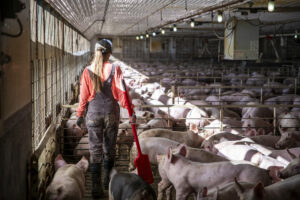Terrain analysts dissect news topics important to agriculture and weigh their significance for the sectors relevant to our Farm Credit customers. In this issue, our analysts discuss the U.S.-Mexico corn controversy, daily trading limits in cattle contracts, and the possibility of new U.S. alcohol consumption guidelines. With looming large carryover stocks and a record national yield forecast, export markets like Mexico are vital to support higher U.S. corn prices. Is Mexico’s GMO Position a Threat to U.S. Grain Exports? Bree Baatz, Grain & Oilseed Analyst Overview In her October 1 inauguration speech, Mexico’s new president, Claudia Sheinbaum, doubled down on Mexico’s position to restrict the use of genetically modified (GM) grain for human consumption. The corn controversy pertains to white corn used in tortillas, with Mexico aiming to protect domestic corn biodiversity and address perceived health risks associated with GM corn. The U.S. argues there is no scientific evidence to support these claims. The tortilla tensions have escalated, with the U.S. now claiming Mexico is in violation of the U.S.-Mexico-Canada trade agreement. A third-party panel is expected to rule on the dispute in November. The good news for U.S. producers is that both countries do agree GM yellow corn is acceptable for animal feed. Yellow corn made up 99% of U.S. corn exports to Mexico in 2023/2024. Notable Quote “Agricultural Image reported, ‘The head of the Secretariat of Agriculture and Rural Development (Sader), Julio Berdegué Sacristán, stated that a major priority for the new administration is to increase food production for national consumption and the country will continue to be self-sufficient in non-transgenic white corn for human consumption.’ ” – “Mexican Officials: No Planting, Consumption of GMO White Corn,” an October 2024 Fence Post article Takeaway With looming large carryover stocks and a record national yield forecast, export markets like Mexico — the largest corn export market for the U.S. — are vital to support higher U.S. corn prices. Farmers should be aware of the trade tensions and the outcome of the third-party panel ruling in November. If only GM white corn imports are limited and the trade relationship between the two countries stays friendly through and after the argument, the ban would have a minimal impact to U.S. farmers. However, given the potential to review trade agreements, this topic may resurface over time. Nevertheless, Mexico imported a record amount of U.S. corn in 2023/2024, and 2024/2025 U.S. corn exports are off to one of their strongest starts in decades. (For more on the U.S. corn market and trade tensions with Mexico, read our latest Quarterly Corn Outlook. ) High price levels and market volatility at the time of the evaluation exacerbated the annual daily limit adjustments in 2024. CME Adjusts Daily Trading Limits in Live Cattle, Feeder Cattle Contracts Don Close, Executive Head Emeritus Overview On June 3, the Chicago Mercantile Exchange (CME) increased the daily trading limit in the live cattle contract to $7.50 and the expanded limit to $11.25. The daily limit in the feeder cattle contract was increased to $9.25 and the expanded limit to $13.75. The increases were set during a scheduled contract evaluation that occurs each June. High price levels and market volatility at the time of the evaluation exacerbated the annual daily limit adjustments in 2024. Discussions at the CME with cattlemen and industry associations following the June changes have led to the CME evaluating the formula in which daily limits are reviewed and established. The CME has now reexamined the June 3 limit increases. The daily price limit in the live cattle contract was adjusted on October 25 to $6.50, with an expanded limit of $9.75. For feeder cattle, the revised daily limit is $8.25, with an expanded limit of $12.25. Notable Quote “Who is the daily limit expansion really benefiting? Cattlemen or traders?” – “Call the Market,” a September 11, 2024, Progressive Farmer article Takeaway The increase in daily price limits set off a flurry of complaints from cattle producers. They stated that the increased limits enabled futures prices to move much faster than movements in the underlying cash markets, placing hedgers in an unfair cash crunch on margin requirements. Sector Impacts Grain & Oilseeds: Grain and oilseed products have a variable, percent-based daily price limit on future contracts with the Chicago Board of Trade (CBOT)/Chicago Mercantile Exchange (CME). The methodology is thought to be more flexible and transparent to allow prices to expand higher but limit prices when retracting. Effective October 31, the CBOT and CME reset the grain and oilseed price limits, which are evaluated twice a year, by narrowing soybean and soymeal future contracts but leaving corn and wheat futures unchanged. When the CME reduces the daily limits in grain, as it did for soybean and soymeal contracts, price volatility should decrease. There is widespread concern within the wine industry that alcohol consumption limits will be drastically lowered. Wine Industry Wary of 2025 Dietary Guidelines Update Chris Bitter, Senior Wine & Grape Analyst Overview U.S. government dietary guidelines are updated every five years, and a new version is forthcoming in 2025. There is widespread concern within the wine industry that alcohol consumption limits will be drastically lowered. The industry’s main concern is that the process for updating the alcohol component of the guidelines may be flawed and not based in science, as it has been farmed out to an anti-alcohol group, the Interagency Coordinating Committee on the Prevention of Underage Drinking. Notable Quote “Tom Wark, executive director of the National Association of Wine Retailers, revealed in his blog Monday that a ‘well-placed source’ has seen the wording of the proposed recommendation of no safe level of alcohol for the 2025 dietary guidelines.” – “Feds Prepare to Call Wine Unsafe,” a May 21, 2024, Wine-Searcher article Takeaway If this recommendation comes to fruition, the impact on wine sales, which are already under pressure, could be devastating. A change in the alcohol guidelines would affect consumer behavior in the near term and influence recommendations made by those who work in the medical, dietary, nutrition and education fields for years to come.
More Articles
See All Insights
Farmer-owned cooperatives join, $10 million invested into New Mexico agriculture through Rural Roots Endowment
Farm Credit of New Mexico is now Farm Credit association, American AgCredit LAS CRUCES, N.M., (Oct. 2, 2023) – The continued strength and growth of New…
Still recovering from 2023, the hog industry continues to slowly climb to a place with a better view. Margins are still thin, heightening the industry’s risk
American AgCredit (AAC) has pledged $2 million to support GoFarm Hawai‘i, one of the largest and most successful beginning farmer development programs in the nation. The…


